It will be the biggest navigation center in Northern California. Can it end homelessness in this Bay Area county?
It’s going to look as snazzy as an upscale apartment complex, complete with manicured plazas and Bauhaus-evocative architecture, and anyone living there who wants dental work, drug rehab or job help will merely have to take a stroll down the hall.

That’s how San Mateo County’s new navigation center homeless shelter is mapped out — and when the 240-room compound opens in early January in Redwood City, it will also be the biggest such center in Northern California.
The navigation center concept was born in San Francisco in 2015, when then-city homelessness czar Bevan Dufty opened a shelter that, unlike others, combined an array of services with a low entry barrier, allowing street denizens to move in with their partners, possessions and pets, and come or go 24/7. The model has since been adopted around the nation.
The Redwood City complex is a cornerstone of San Mateo County’s plan to bring its unsheltered homeless population down to “functional zero,” meaning anyone living outside is quickly moved indoors. And with that many new rooms bringing to 700 the shelter spots opened up this past year — along with 300 new supportive housing units and 100 rental subsidy vouchers for the unhoused — the county actually has a shot at meeting that goal.
“The size and magnitude of this navigation center will be a game changer in helping San Mateo County achieve functional zero.”
Gail Gilman, chief strategy officer
All Home
The last one-night count in January found at least 1,092 unsheltered people on county streets. With at least $270 million in pandemic-era funding coming through the federal Cares Act and the state’s Project Homekey over the past two years, San Mateo thinks that it can become the first county in the Bay Area to hit that functional zero in the next year or so.
“No one said it would be easy work, but this is the issue of our lifetime,” said County Executive Officer Mike Callagy. “We’re talking about human beings. Nobody should be living under freeways or alongside roadways. We have got to do better.”
The complex — the county’s first navigation center — will be operated by LifeMoves, a 40-year-old nonprofit that runs other shelters and interim housing complexes in the region.
Built with modular housing units on a 2.5-acre plot in a light industrial area along the waterfront, the sleek, white-walled apartments with blue trim will rise to three stories in places. Wide, grassy plazas and courtyards in the middle will give common space to hang out, and clinics holding a wide range of job counselors, nurses, social workers, case managers and others will dot the complex.
An outpatient drug treatment office will be operated by the state Department of Public Health, the California Department of Rehabilitation will staff a job-training office for people with disabilities, and a yet-to-be named provider will run an on-site dental clinic.
The dental service in particular is a rarity for a shelter, but it addresses an acute need often overlooked in long-term unhoused people due to medical neglect.
“It’s hard to get a job or look at yourself in the mirror and feel like yourself when you’re missing key teeth or just have one tooth left,” said LifeMoves CEO Aubrey Merriman. “This society is still a relatively superficial place of first impressions. To be able to smile and look someone in the eyes and say, ‘Here I am,’ is hugely important.”
The center is costing $57 million to build, most of which came from Project Homekey, a $500,000 federal grant, and a $5 million donation from philanthropist John Sobrato.
“If you didn’t know the context, you’d be hard-pressed not to think they just put up a new apartment community,” Merriman said. “How these communities are designed is as critical as the services. We wanted something that speaks to the dignity of the human beings we are serving, something that says you are worthy of the efforts we’re putting in here.
“Our role is to get people off the streets quickly, and then quickly move them to their next and better place. That could mean getting their own apartment with a housing voucher, going to permanent supportive housing, or moving into affordable housing.”
Gail Gilman, chief strategy officer for the regional homelessness nonprofit All Home, said, “The size and magnitude of this navigation center will be a game changer in helping San Mateo County achieve functional zero.”
The San Francisco-based All Home in mid-November released “Big Moves for Housing and Economic Security,” a yearlong study that, among several suggestions, urges all Bay Area counties to develop more facilities with enhanced services like the one in Redwood City. It’s hard to find such large parcels of land in more urban areas like San Francisco, but it’s important to try, Gilman said — not only so shelter residents can have dignity with individual rooms, but also for the capacity to house so many services.
“When people have agency for privacy in their own rooms, and they have ready access to the services they need — like job development — they can recover quicker,” she said. She called Callagy, who was a driving force in developing the nav center, and San Mateo’s goal of functional zero, “a model for other counties.”
LifeMoves operates 1,500 beds in interim housing and shelters in San Mateo and Santa Clara counties, and its records show that 65% of its clients exit the facilities into stable housing.
One of its newest complexes is the Coast House “interim housing” shelter — meaning individual rooms, not group sleeping areas — in a converted 52-room hotel in Half Moon Bay. Though it doesn’t have the full sweep of services the nav center will have, 72% of the nearly 200 people who cycled through there in fiscal year 2022 left for stable housing.
One of them was 57-year-old Joe Salcedo.
He landed at the converted hotel a little more than a year ago after living in his car and struggling with drug addiction, and in early November he moved to his own studio in the nearby village of Montara. Clean and sober from the time he moved into Coast House, he now holds two jobs at a Subway sandwich shop and a CVS pharmacy, and has reunited with his 13-year-old daughter.
None of that would have been possible without the counseling, case management and employment help he got through Coast House, he said.
“Dealing with bills, getting back on track, being able to look people in the eye and say I’m doing fine and mean it — it’s amazing,” Salcedo said. “When you reach out and you have people who really care and want to help, there’s nothing you can’t do. Now, you’ve got to do the footwork, for sure. But it goes hand in hand. I call it piercing the darkness.
“There are a lot of good things that can happen with a place like that navigation center they’re building. I hope it helps a lot of people. You can’t just put people in a room and expect them to fix themselves. You need that TLC — that’s what heals the mind, the soul and the body.”
Kevin Fagan is a San Francisco Chronicle staff writer. Email: kfagan@sfchronicle.com Twitter: @KevinChron
Source: SF Chronicle
Keep up to date with our latest news and industry insights.





